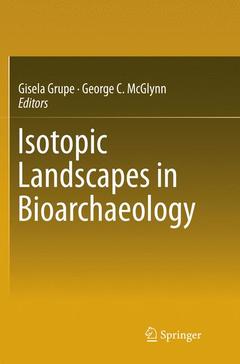Isotopic Landscapes in Bioarchaeology, Softcover reprint of the original 1st ed. 2016
Coordonnateurs : Grupe Gisela, McGlynn George C.

Unanswered Questions in the Evolution of Biomineralization.- Complexities of the Ancient Mortuary Rite of Cremation: An Osteoarchaeological Conundrum.- Bones, Rocks, and Flames: Mineralogy and Petrology of Slags and Cremated Bones from Ritual Immolation Sites in Tyrol.- Radiocarbon Dating of Cremated Finds: An Overview.- Mineralogic Characterisation of Archaeological Bone.- Assessing the ‘local’ 87Sr/86Sr Ratio for Humans.- Determination of Geo-dependent Bio-available 87Sr/86Sr Isotopic Ratios for Archaeoelogical Sites from the Inn Valley (Austria) – a Model Calculation.- Provenancing Bronze: Exclusion, Inclusion, Uniqueness, and Occam’s Razor.- Linking Oxygen Isotopes of Animal-bone Phosphate with Altimetry – Results from Archaeological Finds from a Transect in the Alps.- Oxygen and Hydrogen Stable Isotopes in Earth’s Hydrologic Cycle.- Toward an Integrated Isotope Zooarchaeology.- Assigning Elephant Ivory with Stable Isotopes.- Towards Predicting Places of Origin from Isotopic Fingerprints – A case study on the Mobility of People in the Central European Alps.
Summarizes the outcome of interdisciplinary workshops based on a network of different sciences such as physical anthropology, archaeology, zooarchaeology, geology, mineralogy, and computer sciences with regard to the research potential in future bioarchaeological research
New methods of “fuzzy data mining” by the computer sciences are addressed for the first time
Based on the outcomes of international workshops sponsored by the German Science Foundation and the Centre of Advanced Studies at the Ludwig-Maximilian- University Munich
Date de parution : 04-2018
Ouvrage de 238 p.
15.5x23.5 cm
Disponible chez l'éditeur (délai d'approvisionnement : 15 jours).
Prix indicatif 126,59 €
Ajouter au panier


